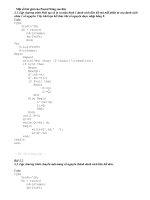48 ASNAT Math _ 123
Bạn đang xem bản rút gọn của tài liệu. Xem và tải ngay bản đầy đủ của tài liệu tại đây (2.16 MB, 40 trang )
ASNAT
Assessing Student’s Needs for
Assistive Technology
ASNAT & Math
Wisconsin Assistive Technology Initiative
www.wati.org
Objectives
• Participants will understand the SETT process
as it relates to identifying appropriate AT for
Math.
• Participants will have basic knowledge of the
AT continuum for Math as identified in the
ASNAT Math Chapter.
• Participants will be able to access resources
and tools for trial with students who need AT
Math supports.
Introduction
• 2009 ASNAT revision
(Assessing Students’ Need for Assistive Technology)
• Uses the SETT framework for AT assessments
Student
Environment
Tasks
Tools
– Framework developed by Joy Zabala 2002
• />F
– Implementation Plan & Follow-up added by WATI
• Revised version has added Sensory
Considerations
Using the SETT
framework
• “Traditional” SETT
– The Student
• Identify the functional area(s) of concern?
• Special needs (related to area of concern)
• Current abilities (related to area of
concern)
• What does the student need to
communicate that is difficult or impossible
to do independently at this time?
Using the SETT
framework
• The Environment(s)
– Arrangement (instructional, physical)
– Support (available to both the student and
the staff)
– Materials and Equipment (commonly used
by others in the environments)
– Access Issues (technological, physical,
instructional)
– Attitudes and Expectations (staff, family,
others)
Using the SETT
framework
• The Tasks
– What SPECIFIC tasks occur in the student’s
natural environments that enable progress
toward mastery of IEP goals and objectives?
– What SPECIFIC tasks are required for active
involvement in identified environments?
(related to communication, instruction,
participation, productivity, environmental
control)
Using the SETT
framework
• The Tools
– Tools include devices, services and strategies…
everything that is needed to help the student
succeed.
– Describe what a useful system of assistive
technology devices and services for the student
would be like.
– Brainstorm Tools that could be included in a
system that addresses student needs.
– Select the most promising Tools for trials in the
natural environments.
– Plan the specifics of the trial (expected changes,
when/how tools will be used, cues, etc.)
– Collect data on effectiveness. (Zabala 2002)
Using the SETT process
Decision Making Guide
WATI’s version
of the SETT
Framework for
Math.
Guide will be
Different for
every area of
AT assessment
Using the Student
Information Guide in the
SETT Process
• The Guide is intended to help the team discuss key
issues when assessing the need for AT for a specific
student.
• It helps teams consider the whole child & environment &
not “jump” to a device!
• It is a group (sped, reg. ed, support staff, admin., parent,
student) process in which everyone contributes.
• Important to write on a large format so that everyone
can see, edit, remember (shared group memory), stay
focused, and be informed!
• Team members take roles of: Facilitator, Recorder, Time
Keeper
Assistive Technology for Math
The Student
Student
List the functional
areas of concern
What are the
student’s special
needs related to the
area of concern.
What are the
student’s
abilities….
What motivates the
student?
Other questions
you might ask?
Assistive Technology for Math
The Environment
Environmental
Considerations
What specific
environmental
considerations need
to be addressed?
Obstacles?
Supports?
Attitudes of others?
What are other the
environments that
need to be taken
into account?
Sensory Considerations
(new)
New section as a subset of Student &
Environment
– Does this student have sensory deficits or
sensitivities that will impact his/her ability to
access math?
– Do the learning environment(s) impact the
sensory issues of the student?
Sensory Considerations
•Visual clutter
•Fluorescent lighting versus full spectrum lighting
•Classroom and background noise
•Tactile stimulation
•Awareness of physical space
•Other individual specific sensitivities
Assistive Technology for Math
The Task
Tasks to Consider
• What does the
student need to do
to achieve
educational goals
from their IEP and
be an active
participant in their
environment?
• What are other
students doing in
the same
environments?
Narrowing the Focus
• As a team, identify by circling or
other means those few tasks the
student needs to do that will have
the most impact.
Solution Generation:
Tools/Strategies
As a team, brainstorm and write on chart
paper any assistive technologies &/or
strategies you think will assist the student
in successfully completing those tasks you
identified.
– Brainstorm possible AT
– Don’t evaluate (yet)!
– Remember to include AT that the student
already uses
– Use all resources including people
Assistive Technology:
past and present
• When brainstorming, be sure to
consider AT tried in the past and
that currently used as the students
strengths, skills and technology
changes
Assistive Technology for Math
The Tools
AT Continuum
• Follow the
progression
of low tech,
through
mid tech to
high tech
when
selecting
assistive
technology
tools
AT for Math
• Math Manipulatives
AT for Math
• Low Tech Physical Access
– Rulers
– Stamps
– Adapted manipulative
AT for Math
• Abacus/Math Line









